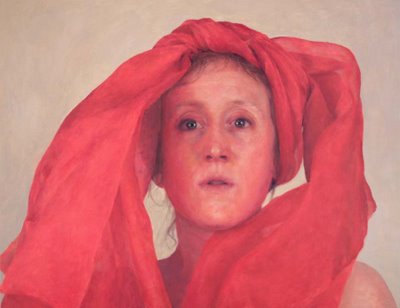6/22/2006

"There's a deftness to the paint handling, & a sense of specificity of texture & light that she nails without being too render-y." - brambles
I love the use of the phrase "too render-y" here, I often try to do the same in my work, especially paintings involving portraiture, it is easy to get caught up in rendering details so much that the brush strokes begin to loose their character, and Dubnau definitely pays attention to this. This is a good thing for me to pay attention to; reading this comment made me think about my own intentions when it comes to representation and treatment of the subject through the energy behind the paint. Jenny Dubnau definitely handles her paint delicately, and there's a softness to the way she treats her characters. It's really quite sweet, she paints as though she finds each of her subjects extremely endearing.
"From the paintings I've seen, she manages, with thin layers of paint, to attain an incredible richness and a heightened emotional state." - bigsurprises
This comment points out the concept of creating an emotional state more with the manner or method of using the paint than with the painting's subject itself. I found this comment helpful because it shows the importance of building a sense of meaning in the painting technique and not relying on your subject matter to portray your message.
"i saw this show and didn't get much beyond the quality of the painting, which is very nice, the color, texture, etc. but i don't think she reached far enough(if at all)beyond her reference to make a Painting. it would have worked much better if she simply showed the photographs." - cornflower
This person is clearly focusing only on the mere fact that the artist paints realistically from photographs, and failed to see the differences in the way Dubnau paints versus other realistic painters. This comment taught me that people won't always pay close attention to the subtleties in the handling of the paint. The question is wether it is better to keep those subtleties and ignore comments like this one, or to paint in a way that makes your intention overly obvious to the viewer. I, for one, appreciate Dubnau's soft subtlety.
"And what is the point of the silly costumes? A witch hat on a grown woman? Is a silly costume or expression enough to make a painting interesting? I don't think so. Also, there has to be something in a painting that isn't ugly or dreary. The work is too politely painted (staid) to be bold and brash. It's some tentative place between realism and expressionism.
The paintings are repetitive. I looked her up online and her earliest painting (2000) is the same as these, figure in the center, against a solid color wall, painted the same way. How about a full figure? A location? A different subject? A development in technique?
The artist seems stuck and needs a change.
Question for the crowd: why do artists make the same thing over and over and over? Do they not realize they are doing it?" - josie
This comment was especially useful to me and my current project. Half-way through the semester I began to ask myself: "What is the importance of costumed characters and clowns?" And of course, I personally care about these characters because they were a huge influence in my life, and I wanted to show the transient circus life and the elements of work and devotion involved, but finally realized how the "clown make-up" is a loaded image, and the last thing I wanted was for my experiences to be portrayed as cliche.
Reading this comment, while I don't necessarily agree with this opinion in terms of Dubnau's work, has re-affirmed my decision to move away from circus characters, specifically clown make-up, and re-examine the essence of what I was interested in with my subject. I'm interested in the element of work: the Labor of love, and the love of labor. What the artist goes through for their work, the artist's routine and the impression of their work on the spaces they exist and work in.
I'm leaving the clowns and circus performers, for a while, and focusing on a more universal element. The next place I explore will be the painter's studio, a setting that is full of years of paint drips, dents, marks, cuts -- the artistic process as preserved by the constant inhabitance of the place.
No comments:
Post a Comment